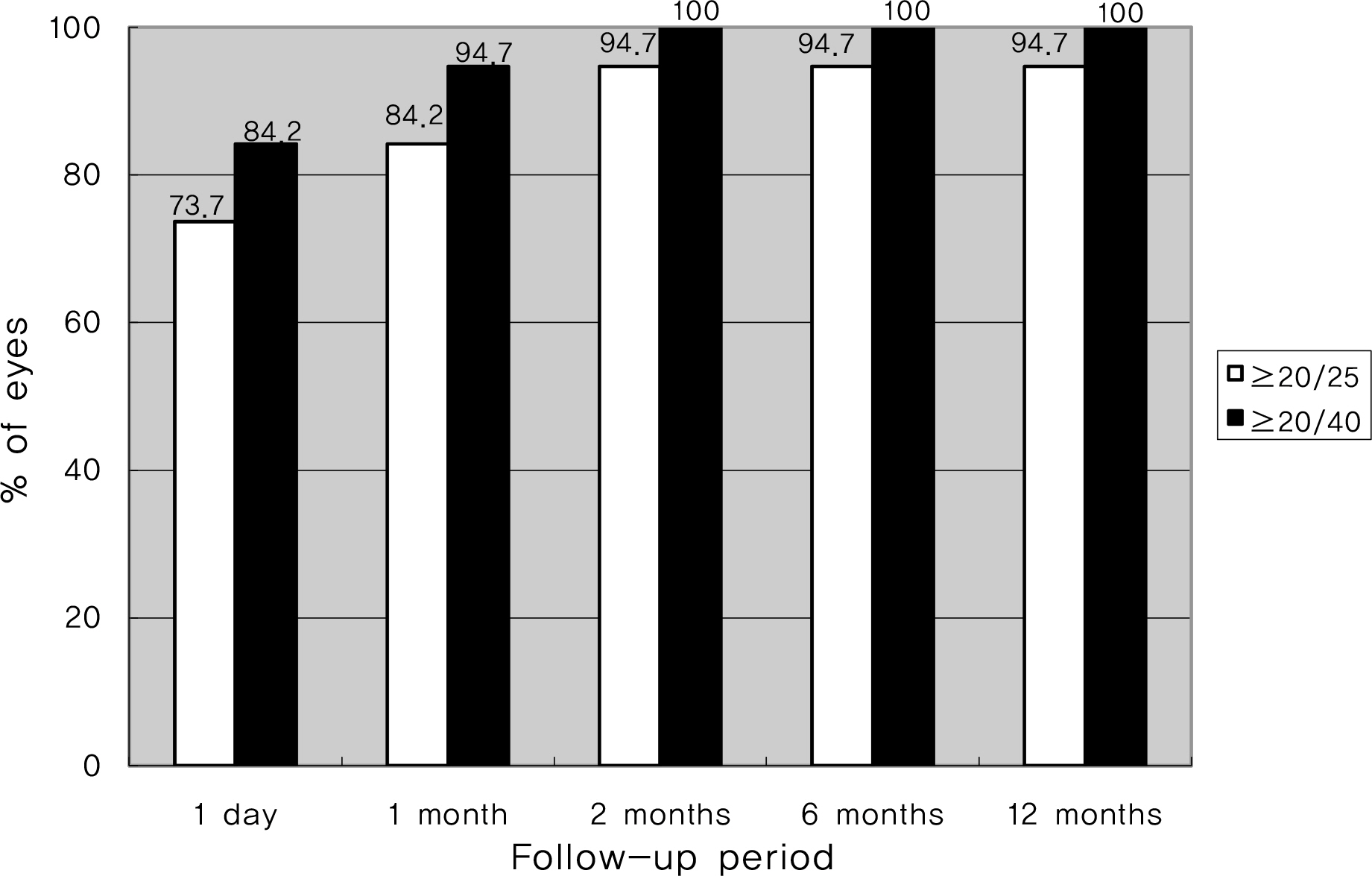J Korean Ophthalmol Soc.
2011 Dec;52(12):1448-1454. 10.3341/jkos.2011.52.12.1448.
Visual Outcome and Stability of Hydrogel Full-Optics Accommodative Intraocular Lens
- Affiliations
-
- 1Department of Ophthalmology, Sahmyook Seoul Hospital, Seoul, Korea.
- 2Department of Ophthalmology and Visual Science, College of Medicine, The Catholic University of Korea, Seoul, Korea. eyedoc@catholic.ac.kr
- KMID: 2215148
- DOI: http://doi.org/10.3341/jkos.2011.52.12.1448
Abstract
- PURPOSE
To report the visual outcome and to determine the stability of WIOL-CF(R) (GELMED, Praha, Czech Republic) hydrogel full-optics accommodative intraocular lens (IOL).
METHODS
The present study evaluated 20 eyes of 10 patients who underwent routine cataract surgery and WIOL-CF(R) accommodative IOL implantation. Measurement included uncorrected/best corrected visual acuities (VA) at near and distant, degree of IOL decentration, degree of IOL tilting and anterior chamber depth on postoperative day 1, 1 month, 2 months, 6 months and 12 months.
RESULTS
Result analysis was performed with 19 eyes of 10 patients, except for 1 complicated eye. At 12 months, the uncorrected distance VA of 11 eyes (57.9%) and 17 eyes (89.5%) were 20/25 and 20/40 or better, respectively. At 12 months, the uncorrected near VA of 12 eyes (63.2%) and 18 eyes (94.7%) were 20/25 and 20/40 or better, respectively. There was no statistically significant difference in anterior chamber depth (p > 0.05), IOL decentration (p > 0.05) and IOL tilting (p > 0.05) on postoperative day 1, 1 month, 2 months, 6 months and 12 months.
CONCLUSIONS
The clinical results of cataract surgery with WIOL-CF were relatively satisfactory.
Figure
Cited by 1 articles
-
Two Cases of WIOL-CF® IOL Dislocation after Nd:YAG Laser Capsulotomy
Byung Jae Kim, Ji Hye Kim, Seong Jae Kim, Yong Seop Han, Jong Moon Park, In Young Chung
J Korean Ophthalmol Soc. 2015;56(3):443-446. doi: 10.3341/jkos.2015.56.3.443.
Reference
-
References
1. Becker KA, Martin M, Rabsilber TM, et al. Prospective, non-rand-omised, long term clinical evaluation of a foldable hydrophilic single piece intraocular lens: results of the Centerflex FDA study. Br J Ophthalmol. 2006; 90:971–4.
Article2. Olson RJ, Werner L, Mamalis N, Cionni R. New intraocular lens technology. Am J Ophthalmol. 2005; 140:709–16.
Article3. Ridley F. Safety requirements for acrylic implants. Br J Ophthalmol. 1957; 41:359–67.
Article4. Leyland M, Zinicola E. Multifocal versus monofocal intraocular lenses in cataract surgery; a systematic review. Ophthalmology. 2003; 110:1789–98.5. Findl O, Leydolt C. Meta-analysis of accommodating intraocular lenses. J Cataract Refract Surg. 2007; 33:522–7.
Article6. Lee JM, Seo KY, Kim EK. Comparison of optical aberrations and contrast sensitivity between monofocal and multifocal intraocular lens. J Korean Ophthalmol Soc. 2002; 43:1882–6.7. Song MJ, Lee MK, Park BI. A Clinical study of 3M multifocal intraocular lens implant. J Korean Ophthalmol Soc. 1991; 32:234–40.8. Montés-Micó R, España E, Bueno I, et al. Visual performance with multifocal intraocular lenses: mesopic contrast sensitivity under distance and near conditions. Ophthalmology. 2004; 111:85–96.9. Sen HN, Sarikkola AU, Uusitalo RJ, Laatikainen L. Quality of vision after AMO Array multifocal intraocular lens implantation. J Cataract Refract Surg. 2004; 30:2483–93.
Article10. Schmitz S, Dick HB, Krummenauer F, et al. Contrast sensitivity and glare disability by halogen light after monofocal and multifocal lens implantation. Br J Ophthalmol. 2000; 84:1109–12.
Article11. Allen ED, Burton RL, Webber SK, et al. Comparison of a diffractive bifocal and a monofocal intraocular lens. J Cataract Refract Surg. 1996; 22:446–51.
Article12. Rossetti L, Carraro F, Rovati M, Orzalesi N. Performance of diffractive multifocal intraocular lenses in extracapsular cataract surgery. J Cataract Refract Surg. 1994; 20:124–8.
Article13. Kamlesh , Dadeya S, Kaushik S. Contrast sensitivity and depth of focus with aspheric multifocal versus conventional monofocal intraocular lens. Can J Ophthalmol. 2001; 36:197–201.
Article14. Davison JA, Simpson MJ. History and development of the apo-dized diffractive intraocular lens. J Cataract Refract Surg. 2006; 32:849–58.
Article15. Slagsvold JE. 3M diffractive multifocal intraocular lens: eight year followup. J Cataract Refract Surg. 2000; 26:402–7.
Article16. Cumming JS, Ritter JA. The measurement of vitreous cavity length and its comparison pre- and postoperatively. Eur J Implant Refract Surg. 1994; 6:261–72.
Article17. Cumming JS, Slade SG, Chayet A. Clinical evaluation of the mod-el AT-45 silicone accommodating intraocular lens: results of feasi-bility and the initial phase of a Food and Drug Administration clinical trial. Ophthalmology. 2001; 108:2005–9.
Article18. Cumming JS, Colvard DM, Dell SJ, et al. Clinical evaluation of the Crystalens AT-45 accommodating intraocular lens: results of the U.S. Food and Drug Administration clinical trial. J Cataract Refract Surg. 2006; 32:812–25.19. Kwon JW, Kang S, Chung SK, Baek NH. Clinical results of Crystalens® (AT-45) accommodating intraocular Lens. J Korean Ophthalmol Soc. 2009; 50:1179–83.20. Kim C, Kwon JW, Wee WR, et al. Factors affecting the visual outcome of cataract surgery in the very elderly. J Korean Ophthalmol Soc. 2007; 48:905–10.21. Morrison JD, Jay JL. Changes in visual function with normal ageing, cataract and intraocular lenses. Eye. 1993; 7:20–5.
Article22. Jay JL, Mammo RB, Allan D. Effect of age on visual acuity after cataract extraction. Br J Ophthalmol. 1987; 71:112–5.
Article23. Dogru M, Honda R, Omoto M, et al. Early visual results with the 1CU accommodating intraocular lens. J Cataract Refract Surg. 2005; 31:895–902.
Article24. Marchini G, Mora P, Pedrotti E, et al. Functional assessment of two different accommodative intraocular lenses compared with a monofocal intraocular lens. Ophthalmology. 2007; 114:2038–43.
Article25. Küchle M, Seitz B, Langenbucher A, et al. Comparison of 6-month results of implantation of the 1CU accommodative intraocular lens with conventional intraocular lenses. Ophthalmology. 2004; 111:318–24.
Article
- Full Text Links
- Actions
-
Cited
- CITED
-
- Close
- Share
- Similar articles
-
- The Prognostic Factors that Influence in Near Vision after Accommodative Intraocular Lens Implantation
- The Development of Injectable Intraocular Lens Using Thermosensitive Polymeric Hydrogel in Vitro and in Vivo
- Clinical Evaluation of IOGEL 1103Lens Implantation
- Late Postoperative Opacification of the Foldable Hydrophilic Acrylic Intraocular Lens, ACRL-160
- Multifocal Intraocular Lens Implantation after Pars Plana Vitrectomy to Treat Retinal Detachment







